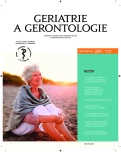Chronic pancreatitis in the old age
Authors:
M. Berková; Z. Berka; E. Topinková
Published in:
Geriatrie a Gerontologie 2015, 4, č. 2: 81-86
Category:
Review Article
Overview
Chronic pancreatitis (ChP) is a progressive inflammatory process, characterized by successive fibrotization of the gland. The incidence of chronic pancreatitis in the Czech Republic is almost at 8 new cases/100 000 inhabitants/year. The genesis of chronic pancreatitis after sixty years of age is rare, in most cases the disease begins in earlier life periods. The aetiology factors of ChP are summarized in the TIGAR-O classification. The most common cause of chronic pancreatitis is alcoholism. In the case of late onset of the disease in elderly people it is necessary to think of biliary or autoimmune aetiology, but often the aetiology remains unclear. The abdominal pain is frequent in younger people, but it may not dominate in older patients if sensitive neural terminals are destroyed. The main signs of pancreatic insufficiency are malabsorption and malnutrition, in advanced stages diabetes mellitus tends to develop as well. Routine laboratory examination shows little sensitivity and specificity in ChP. The most important role in diagnostics is played by imaging techniques (computed tomography and nuclear magnetic resonance imaging). Besides conservative treatment, the newer invasive procedures, or in some indicated cases surgery, are available as well.
Keywords:
chronic pancreatitis – TIGAR-O classification – steatorrhoea – malnutrition – pancreatine
Sources
1. Dítě P, Trna J, Floreanová K, Geryk E. Chronická pankreatitida. Med praxi 2011; 8(11): 455–458.
2. Yadav D, Timmons L, Benson JT, et al. Incidence, prevalence, and survival of chronic pancreatitis: a population-based study. Am J Gastroenterol 2011;106(12):2192–2199.
3. Barman K, Premalatha G, Mohan V. Tropical chronic pancreatitis. Postgrad Med J 2003; 79(937): 606–615.
4. Brock C, Nielsen LM, Lelic D, Drewes AM. Pathophysiology of chronic pancreatitis. World J Gastroenterol 2013; 19(42): 7231–7240.
5. Ševčíková A. Od chronické nehereditární pankreatitidy k pankreatickému karcinomu. Sborník přednášek Aktuální gastroenterologie XVII. X/05.
6. Sah RP, Chari ST, Pannala R, et al. Differences in clinical profile and relapse rate of type 1 versus type 2 autoimmune pancreatitis. Gastroenterology 2010; 139:140–148.
7. Kamisawa T, Anjiki H, Egawa N. Rapid changes in sclerosing cholangitis associated with autoimmune pancreatitis. Pancreas 2009; 38: 601–602.
8. Detlefsen S, Bräsen JH, Zamboni G, et al. Deposition of complement C3c, immunoglobulin (Ig)G4 and IgG at the basement membrane of pancreatic ducts and acini in autoimmune pancreatitis. Histopathology 2010; 57: 825–835.
9. Chari ST, Longnecker DS, Klöppel G. The diagnosis of autoimmune pancreatitis: a Western perspective. Pancreas 2009; 38: 846–848.
10. Frulloni L, Lunardi C, Simone R. Identification of a novel antibody associated with autoimmune pancreatitis. N Engl J Med 2009; 361: 2135–2142.
11. Deshpande V, Gupta R, Sainani N, Sahani DV, et al. Subclassification of autoimmune pancreatitis: a histologic classification with clinical significance. Am J Surg Pathol 2011; 35: 26–35.
12. Klöppel G, Detlefsen S, Chari ST, et al. Autoimmune pancreatitis: the clinicopathological characteristics of the subtype with granulocytic epithelial lesions. J Gastroenterol 2010; 45: 787–793.
13. Wang Q, Zhang X, Zhang F. Autoimmune pancreatitis: current concepts. Sci China Life Sci 2013; 56(3): 246-253.
14. Zamboni G, Lüttges J, Capelli P. Histopathological features of diagnostic and clinical relevance in autoimmune pancreatitis: a study on 53 resection specimens and 9 biopsy specimens. Virchows Arch 2004; 445: 552–563.
15. Lowes JR, Rode W, Lees WR, et al. Obstructive pancreatitis: Unusual causes of chronic pancreatitis. Br J Surgery 1988; 75(11): 1129–1133.
16. Buscher HC, Wilder-Smith OH, van Goor H. Chronic pancreatitis patients show hyperalgesia of central origin: a pilot study. Eur J Pain 2006; 10: 363–370.
17. Smyth RL. Fibrosing colonopathy in cystic fibrosis. Arch Dis Child 1996; 74(5): 464–468.
18. Bansi DS, Price A, Russell C, Sarner M. Fibrosing colonopathy in an adult owing to over use of pancreatic enzyme supplements. Gut 2000; 46: 283–285.
19. Vávrová V. Fibrotizující kolonopatie. In: Vávrová V. Cystická fibróza. Grada Publishing 2006: 307–308.
20. Warshaw AL, Banks PA, Fernandez-del Castillo C. AGA technical review. Treatment of pain in chronic pancreatitis. Gastroenterology 1998; 115: 765–776.
21. Gachago C. Draganov PV. Pain management in chronic pancreatitis. World J Gastroenterol 2008; 14: 3137–3148.
22. Topazian M, Witzig TE, Smyrk TC, et al. Rituximab therapy for refractory biliary strictures in immunoglobulin G4-associated cholangitis. Clin Gastroenterol Hepatol 2008; 6: 364–366.
23. Khosroshahi A, Bloch DB, Deshpande V, Stone JH. Rituximab Therapy Leads to Rapid Decline of Serum IgG4 Levels and Prompt Clinical Improvement in IgG4-Related Systemic Disease. Arthritis Rheum 2010; 62(6): 1755–1762.
24. Tandan M, Reddy DN, Santosh D, et al. Extracorporeal shock wave lithotripsy and endotherapy for pancreatic calculi-a large single center experience. Indian J Gastroenterol 2010; 29: 143–148.
25. Aghdassi AA, Mayerle J, Kraft M, et al. Pancreatic pseudocysts – when and how to treat? HPB (Oxford) 2006; 8(6): 432–441.
26. Nøjgaard C. Prognosis of acute and chronic pancreatitis – a 30-year follow-up of a Danish cohort. Dan Med Bull 2010; 57(12): B 4228.
Labels
Geriatrics General practitioner for adults Orthopaedic prostheticsArticle was published in
Geriatrics and Gerontology

2015 Issue 2
Most read in this issue
- Chronic pancreatitis in the old age
- Nutritional support in dementia patiens
- Chronic heart failure – specifics of treating seniors
- Chest pain in a patient with thoracic aorta dissection
